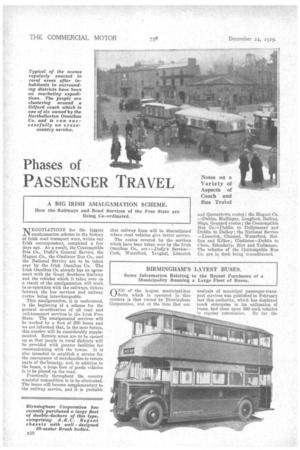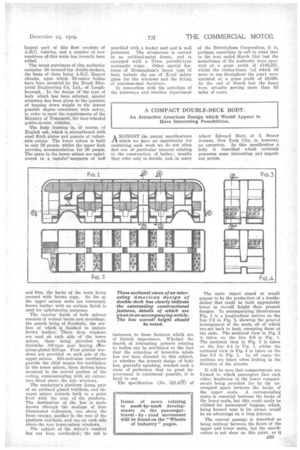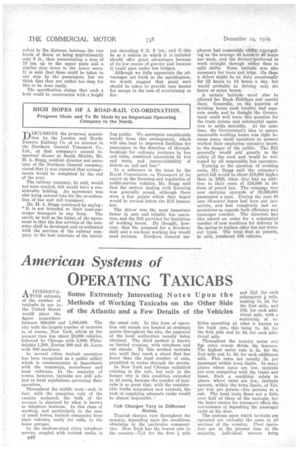Phases of PASSENGER TRAVEL
Page 56

Page 57

Page 58

If you've noticed an error in this article please click here to report it so we can fix it.
1\TEGOTIATIONS for the biggest ,IN amalgamation scheme in the history Of Irish road transport were, writes our Irish correspondent, completed a few days ago. As a result, the Contemptible Bus Co., Duffy's General Service, the Magnet Co., the Gladiator Bus Co., and the National Service are to be taken over by the Irish Omnibus Co. The Irish Omnibus Co. already has an agreement with the Great Southern Railway and the vehicles which it takes over as a result of the amalgamation will work in co-operation with the railways, tickets between the bus services and railway routes being interchangeable.
This amalgamation, it is understood, is the beginning of a scheme for the general co-ordination of all road arid rail-transport services in the Irish Free State. The amalgamated services will be worked by a fleet of 200 buses and we are informed that, in the near future, this number will be considerably supplemented. Remote areas are to be opened up so that people in rural districts will be provided with greater facilities for communicating with the towns. It is also intended to establish a service for the conveyance of merchandise to remote parts of theeountry, and, in addition to the buses, a large fleet of goods vehicles is to be placed on the road.
Practically throughout the country wasteful competition is to be eliminated. The buses will become conwlementary to the railway service, and it is probable that railway lines will be discontinued where road vehicles give better service.
The routes covered by the services which have been taken over by the Irish Omnibus Co., are :---Duffy's Service— Cork, Waterford, Youghal, Limerick and Queenstown routes ; the Magnet Co. —Dublin, Mullingar, Longford, Manna, Sligo, Granard routes; the Contemptible Bus Co.—Dublin to Dollymount and Dublin to Dalkey; the National Service —Limerick, Clonmel, Waterford, Ballina. and Kilkee ; Gladiator—Dublin to Claim, kidenderry, Birr and Tullamore. The vehicles of the Contemptible Bus Co. are in dock being reconditioned.
ONE] of the largest municipal-bus fleets which is operated in this country is that owned by Birmingham Corporation, and at the time that our
analysis of municipal passenger-trans Port sdrvices was published in February last this authority, which has displayed much enterprise in its utilization of buses, had close upon 300 such vehicles m regular commission. By far the largest part of this fleet consists of A.E.C. vehicles, and a number of new machines of this make has recently been added.
The latest purchases of this authority comprise 30 covered-top double-deckers, the basis of them being A.E.C. Regent chassis, upon which 50-seater bodies have been mounted by the Brush Electrical Engineering Co, Ltd., of Loughborough.. In the design of the type of body which has been adopted, special attention has been given to. the question of keeping down weight to the lowest possible degree consistent with safety, in order to meet the requirements of the Ministry of Trait-wort, for four-wheeled public-service vehicles.
The body framing is, of course, of English ash, which is strengthened with steel flitch plates and gussets at vulnertilde points. The lower saloon is built to seat 24 people, whilst the upper deck provides accommodation for 26 people. The seats in the lower saloon are upholstered in a tastefull moquette of buff
and blue, the backs of the seats being covered with brown repp. So far as the upper saloon seats are concerned, brown leather with an antique finish is used for upholstering purposes.
The interior finish of both saloons consists of walnut bands and mouldings, the panels being of Sundeala, the surface of which is finished to imitate brown leather. Three drop windows are used on each side of the lower saloon, these being provided with Quicktho NS-type gear having dromium-plated fittings. Four similar windows are provided on each side of the upper saloon. Hit-and-miss ventilators -provide the chief means for ventilation in the lower saloon, these devices being mounted in the curved portion of the ceiling, communicating with air extractors fitted above the side windows.
The conductor's platform forms part of an enclosed glazed vestibule, and the upper saloon extends back to a point level with the rear of the platform. The destination of the bus is made known through the medium of four illuminated indicators, one above the front canopy, another in the rear of the platform vestibule, and one on each. side above the rear lower-saloon windows.
. The subject of the driver's comfort has not been overlooked ; the cab is
provided with a bucket seat and is well protected. The windscreen is carried in an oxidized-metal frame, and is equipped with a Trico parallel-type automatic wiper. Other special features• of Birmingham's latest type 'of body include the use of Xetal safety glass for the windows and the fitting of stainless-steel furniture.
In connection with the activities of the tramways and omnibus department
of the Birmingham Corporation, it is, perhaps, opportune to call to mind that in the year ended March 31st last the motorbuses of the authority were•operated at a gross profit of .£146,387, whilst the trolley-buses (of which 16 were in use throughout the year) were operated at a gross profit of £6,693. At the end of March last the buses were actually serving more than 85 miles of route.
AMONGST the patent specifications which we have an opportunity for examining each week we do not often find one of particular interest relating to the construction of bodies ; usually they refer only to details, and, in many instances, to those featureswhich are of limited importance. Whether the dearth of interesting patents relating to bodies can be attributed to the fact that the attention of inventive minds has not been directed to this subject, or whether the present design of body has, generally speaking, reached such a state of perfection that no great improvement is conSidered possible, it is hard to say.
The specification (No. 321,817) of Albert Edward Hutt, of 5, Storer Avenue, New York City, is, however, an exception. In this specification a body is described which certainly possesses some interesting and important points.
The main object aimed at would appear to be the production of a doubledecker that could be built appreciably lower in overall height than present designs. In accompanying illustrations Fig. 1 is a longitudinal section on the line 2-2 in Fig. 3, showing the general arrangement of the seats, all of which areset back to back, excepting those at the ends. The sectional view in Fig. 2 is taken on the line 6-6 in Fig. 1. The sectional view in Fig. 3 is taken on the line 4-4 in Fig. 1, whilst the sectional view in Fig. 4 is taken on the line 5-5 in Fig. 1. In all eases the sections are taken when looking in the direction of the arrows.
It will be seen that compartments are formed in which passengers face each other, headroom in the lower compartments being provided for by the unoccupied space between the backs of the upper seats. A corresponding space is essential between the backs of the lower scats, but this could easily be utilized for passengers' luggage, which, being housed near to its owner, would be an advantage on a long journey.
The eentral passage is described as being midway between the floors of the upper and lower seats, but the specification is not clear on this point, as it refers to the distance between the two levels of floors as being approximately only 3 ft., thus necessitating a step of 18 ins, up to the upper seats and a similar step down to the lower seats. It is said that these could be taken in one step by the passengers, but we think that they are rather too deep for this to be done easily.
The specification claims that such a body could be constructed with a height not exceeding 8 ft. 9 ins., and if this be so a vehicle in which it is included should offer great advantages because of its low centre of gravity and because it could pass under low bridges.
Although we fully appreciate the advantages set forth in the specification, we would suggest that great care should be taken to provide easy means for escape in the case of overturning or fire.
TAISCUSSING the proposed acquisi tion by. the London and NorthEastern Railway Co. of an interest in the Northern General Transport Co., Ltd., at that company's annual inspectors' dinner at South. Shields, Mr. H. A. Stagg, resident director and secretary of the Northern General company, stated that it was expected that arrangements would be completed by the end of the year.
The railway company, he said, would not have control, but would have a considerable holding. An agreement was also being entered into for the co-ordination of bus and rail transport Mr. H. A. Stagg continued by saying: "It is not intended to limit road-pas senger transport in any form. The spirit, as well as the letter, of the agreement is that the bus services of the company shall be developed and co-ordinated with the services of the railway company in the best interests of the travel ling public. We anticipate considerable benefit from this arrangement, which Will also lead to improved facilities for passengers in the direction of throughbookings for ordinary journeys by bus and train, combined excursions by bus and train, and interavailability of tickets on rail and bus."
In a reference to the issue by the Royal Commission on Transport of its report on the licensing and regulation of public-service vehicles, Mr. Stagg said that the section dealing with licensing Was generally sound, although there were a few points which they hoped would be revised before the Bill became law.
The driver was the most important factor in safe and reliable bus operation, and the Bill provided for limitation of working hours. He thought, however, that the proposal for a five-hour shift and a ten-hour working day would need revision. Northern General em -ployees had reasonable shifts, 'aggregating on the average 48 hours to 49 hours per week, and the drivers -preferred to work straight through rather than to split shifts. Some latitude was also necessary for tours and trips. On these a driver might be on duty occasionally for 12 hours to 14 hours a day, but would probably be driving only six hours or seven hours.
A certain latitude must also be allowed for Bank Holidays and special days. Generally, on the question of working hours each locality had separate needs, and he thotight the Government could well leave this question for the trade unions and substantial operators to settle amicably. At the same time, the Government's idea to ensure reasonable working hours was right because many small operators at present worked their employees excessive hours. to the danger of the public. The Bill generally would add greatly to the safety of the road and would be welcomed by all responsible bus operators.
Turning to the question of working costs, Mr. Stagg said the company's petrol bill would be about £18,000 higher than in 1928, when they had an addition to their costs of £24,000 in the form of petrol tax. The company was now carrying upwards of 38,000,000 passengers a year. During the year 40 new 34-seater buses had been put into service, and had completely met expectations as regards both efficiency and passenger comfort. The directors had also placed an order for a substantial number of new machines for delivery in the spring to replace older but not wornout types. The total fleet at present, he said, numbered 330 vehicles.




































































































